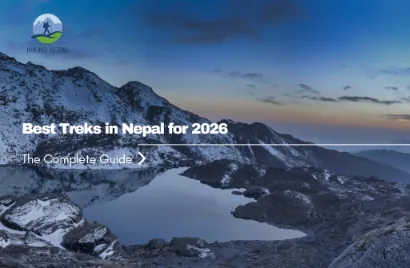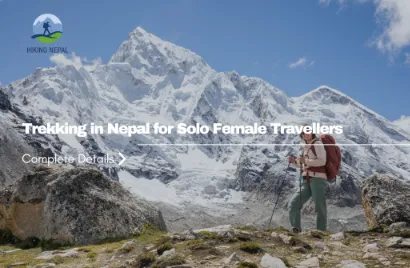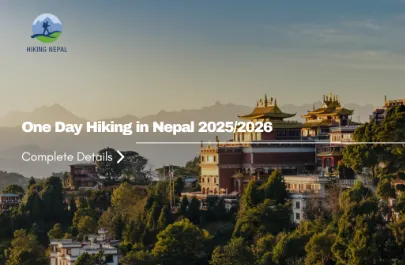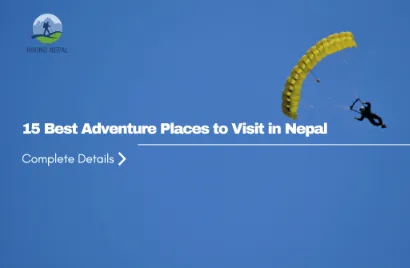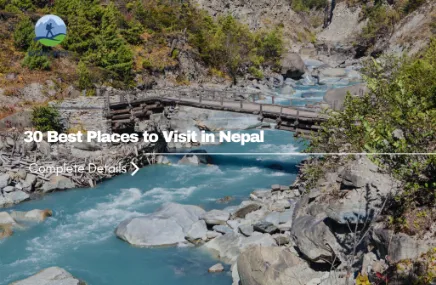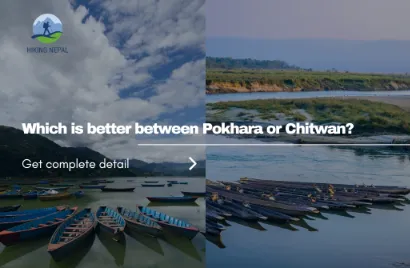Nepal is often known for its long treks into the Himalayas, but not every traveler has weeks to spare. Sometimes you only want a short escape into the hills, a walk through forests, and a chance to meet local people before returning to the city by evening. That is where one-day hikes come in. These short trips are perfect for those with limited time or anyone who wants to experience the culture, scenery, and nature of Nepal without the demands of multi-day trekking.
One-day hiking in Nepal can be done around Kathmandu and Pokhara, the two most popular travel hubs. Trails lead to ancient temples, Buddhist monasteries, Himalayan viewpoints, and quiet villages tucked away from the busy streets. The walks are not too hard, and anyone can do most with basic fitness. Along the way, you can enjoy tea in small shops, chat with locals, and take in the views of terraced fields and snow-capped peaks.
Here are some of the curated one-day hikes in Nepal for 2025/2026 by Hiking Nepal.
Sundarijal Hike (From Kathmandu)
The Sundarijal hike starts only an hour away from Kathmandu and takes you into Shivapuri National Park. The trail passes through waterfalls, forests of oak and rhododendron, and small Tamang villages. Sundarijal is also the starting point for the longer Helambu and Langtang treks, but even a short day hike here gives you a taste of Nepal’s hills.
Why it’s special: You walk through fresh forests, hear birds singing, and can stop at monasteries along the way. The waterfalls during the monsoon make it even more scenic.
Kathmandu–Namobuddha–Dhulikhel Hike (From Kathmandu)
This is a cultural and spiritual walk southeast of the valley. Starting near Panauti, you climb to Namobuddha, a significant Buddhist pilgrimage site featuring a stupa and monastery. From there, continue to Dhulikhel, a small town with Himalayan views and traditional Newari houses.
Why it’s special: The hike combines history, religion, and natural beauty. Pilgrims believe Buddha once offered his body to a starving tigress here, and the views of Langtang and Gaurishankar mountains from Dhulikhel are stunning.
Nagarkot One Day Trek (From Kathmandu)
Nagarkot is famous for its sunrise views. A popular one-day hike begins in Changunarayan, a UNESCO World Heritage temple, and then climbs through villages and terraced fields up to Nagarkot. From the top, you see a long line of snow peaks, including Everest on clear days.
Why it’s special: This trail blends heritage and mountain scenery in one day. Walking through the villages gives you a glimpse of rural Nepalese life.
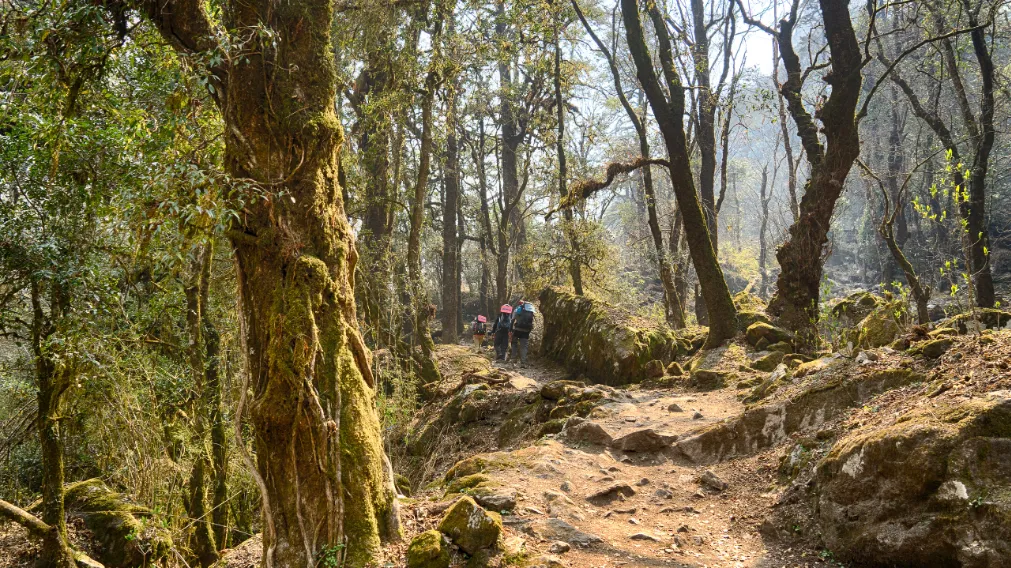
Ranikot Village Trek (From Kathmandu)
Ranikot lies on the eastern rim of the Kathmandu Valley, a peaceful hilltop with sweeping views of the valley floor and the snow peaks beyond. The trek begins near Bhaktapur and takes you through terraced farms, pine forests, and small villages. Unlike more popular trails, Ranikot remains quiet, making it an ideal choice for those seeking solitude close to the capital. From the ridge, you can see Kathmandu, Bhaktapur, and Lalitpur spread out below, along with a distant line of Himalayan mountains.
Why it’s special: The hike combines nature with rural charm. You pass traditional houses and farmland where locals still live much as they have for generations. It is also close enough to enjoy as a day trip without a long travel.
Best Time to Visit Ranikot Village
Season | Features |
| Spring (Mar–May) | Clear skies, flowers blooming, pleasant temperatures |
| Summer (Jun–Aug) | Green fields, occasional rain showers |
| Autumn (Sep–Nov) | Best mountain views, festivals in villages |
| Winter (Dec–Feb) | Crisp air, fewer tourists, chilly mornings |
Bagdwar Hike (From Kathmandu)
Bagdwar is considered the source of the Bagmati River, a sacred river for Hindus and Buddhists that flows through the Kathmandu Valley. The hike begins from Shivapuri National Park and takes you into dense forests filled with oak, rhododendron, and pine. The trail climbs steadily until you reach a clearing with small shrines and springs marking the origin of the river. It is a peaceful and spiritual spot where pilgrims come to pay respect.
Why it’s special: The hike connects nature with culture. It offers a chance to walk in a tranquil forest while also experiencing the sacred importance of the Bagmati River. For many visitors, the calm of Bagdwar is a refreshing break from the busy city.
Best Time to Visit Bagdwar
Season | Features |
| Spring (Mar–May) | Blooming rhododendrons, comfortable weather |
| Summer (Jun–Aug) | Lush green forest, but leeches and rain are common |
| Autumn (Sep–Nov) | Best clarity and forest walks, cool air |
| Winter (Dec–Feb) | Cold mornings, quiet trails, clear skies |
Hike to Phulchowki (From Kathmandu)
Phulchowki is the highest hill surrounding the Kathmandu Valley, located at 2,782 meters. The trail starts from Godawari, about 14 kilometers from the city, and climbs steeply through thick forests. Along the way, you’ll find a diverse array of plants, butterflies, and birds, making it a paradise for nature enthusiasts. At the summit, a small shrine sits on the ridge, and the views stretch from the Himalayan range in the north to the plains of Terai in the south.
Why it’s special: Phulchowki is known for its biodiversity. During spring, the hill is covered in blooming rhododendrons, while in winter it sometimes receives snowfall, creating a magical scene so close to Kathmandu.
Best Time to Visit Phulchowki
Season | Features |
| Spring (Mar–May) | Wildflowers, orchids, and birdwatching |
| Summer (Jun–Aug) | Rainy, muddy trails but lush greenery |
| Autumn (Sep–Nov) | Best views, cool weather, clear skies |
| Winter (Dec–Feb) | Occasional snow, crisp air, fewer crowds |
Sankhu to Bajrayogini Hike (From Kathmandu)
This cultural hike begins in the ancient Newar town of Sankhu, situated northeast of Kathmandu. From its narrow streets and traditional architecture, the trail climbs through farms and forests to the sacred Bajrayogini Temple. The temple is an important Buddhist pilgrimage site believed to be more than 1,000 years old. The setting is peaceful, with stone steps, shrines, and natural springs.
Why it’s special: This hike combines history, culture, and religion. Walking from Sankhu to Bajrayogini gives you a chance to experience village life and visit one of the oldest spiritual sites in the valley.
Best Time to Visit Sankhu–Bajrayogini
Season | Features |
| Spring (Mar–May) | Warm weather, blooming flowers |
| Summer (Jun–Aug) | Rain makes the trail slippery, but lush greenery |
| Autumn (Sep–Nov) | Best time for clear skies and cultural festivals |
| Winter (Dec–Feb) | Chilly mornings, quiet trails, good visibility |
Dhampus Village Trek (From Pokhara)
Dhampus is a traditional Gurung village in the Annapurna region, only a few hours from Pokhara. The hike takes you through terraced fields, forests, and scattered farmhouses before arriving at the village perched on a ridge. From Dhampus, you get panoramic views of the Annapurna range, Machapuchare (Fishtail), and Dhaulagiri. The village itself has stone-paved paths and warm hospitality, making it an excellent cultural stop.
Why it’s special: Dhampus is one of the best spots for sunrise and sunset views over the mountains. It is also a great place to learn about Gurung culture while enjoying a short and easy trek from Pokhara.
Best Time to Visit Dhampus
Season | Features |
| Spring (Mar–May) | Flowers and clear skies, pleasant temperature |
| Summer (Jun–Aug) | Lush greenery, but rain showers are common |
| Autumn (Sep–Nov) | Best mountain visibility, cultural activities |
| Winter (Dec–Feb) | Cold mornings, stunningly clear skies |
Peace Stupa and Pumdikot Day Hike (From Pokhara)
This hike begins near Lakeside Pokhara and climbs up through forests and local villages to the World Peace Stupa. The gleaming white monument sits on a hilltop, overlooking Phewa Lake and the city. From here, the trail continues to Pumdikot, where a large Shiva statue and another viewpoint offer spectacular scenery of the Annapurna and Dhaulagiri ranges.
Why it’s special: The walk gives both cultural and natural highlights in one trip. The Peace Stupa is a serene place of reflection, while Pumdikot offers some of the best views of Pokhara, including the lake and surrounding mountains.
Best Time to Visit Peace Stupa & Pumdikot
Season | Features |
| Spring (Mar–May) | Blooming forests, clear skies |
| Summer (Jun–Aug) | Lush landscapes, some rain |
| Autumn (Sep–Nov) | Best clarity and comfortable weather |
| Winter (Dec–Feb) | Chilly but excellent visibility |
Naudanda Day Hike (From Pokhara)
Naudanda is a beautiful hilltop west of Pokhara that offers expansive, open views of the Annapurna range and Phewa Lake. The hike begins from Lakeside or Kaskikot, gradually ascending through terraced farmlands and scattered villages. Along the trail, you’ll see daily rural life, from farmers tending to their crops to children walking to school. By the time you reach Naudanda, you’re rewarded with a sweeping panorama that stretches from Dhaulagiri to Machapuchare, with Pokhara nestled below.
Why it’s special: Naudanda is less crowded than other viewpoints around Pokhara, making it peaceful and relaxed. The combination of natural beauty, quiet trails, and authentic village scenery makes it a perfect choice for those who want to escape the busy city for a day.
Best Time to Visit Naudanda
Season | Features |
| Spring (Mar–May) | Flowers blooming, moderate weather |
| Summer (Jun–Aug) | Green hills, occasional rain showers |
| Autumn (Sep–Nov) | Best visibility of peaks, comfortable hiking conditions |
| Winter (Dec–Feb) | Cold but crystal-clear skies |
Thulakot Hill Trek (From Pokhara)
Thulakot is a lesser-known hill near Pokhara that offers outstanding views without the crowds. The trek usually starts from Bijayapur or Kalikasthan, winding uphill through farmlands, forests, and traditional homes. Once you reach the ridge, you’ll find yourself surrounded by views in every direction. The Annapurna massif rises in the north, while the valley of Pokhara and Phewa Lake lie far below.
Why it’s special: Thulakot is quieter compared to other hikes around Pokhara, giving it an untouched feel. It’s also one of the best spots for sunrise, when the mountains glow orange and the lake sparkles in the valley below.
Best Time to Visit Thulakot
Season | Features |
| Spring (Mar–May) | Pleasant temperatures, rhododendron blooms |
| Summer (Jun–Aug) | Lush greenery, but muddy trails |
| Autumn (Sep–Nov) | Clear skies, warm days, festivals in villages |
| Winter (Dec–Feb) | Crisp mornings, best long-range views |
Sarangkot Trek (From Pokhara)
Sarangkot is the most famous viewpoint near Pokhara, and for good reason. The hike begins directly from Lakeside, climbing steadily through stone stairways, forests, and small settlements. At the top, you’re greeted with a breathtaking view of the Annapurna range, Dhaulagiri, and Machapuchare. Below, the city of Pokhara spreads out, with Phewa Lake reflecting the morning light. Sarangkot is also known for adventure activities, such as paragliding, which take off from its ridge.
Why it’s special: Sarangkot is unmatched for its stunning sunrise views. Watching the first rays of the sun hit the snow-capped peaks is an unforgettable experience. Its accessibility from Pokhara also makes it one of the most rewarding short hikes in Nepal.
Best Time to Visit Sarangkot
Season | Features |
| Spring (Mar–May) | Warm, colorful flowers, good sunrise views |
| Summer (Jun–Aug) | Cloudy mornings, lush greenery |
| Autumn (Sep–Nov) | Best clarity, perfect for photography |
| Winter (Dec–Feb) | Clear skies, chilly but stunning visibility |
Kahun Danda, Kahu Deurali (From Pokhara)
Kahun Danda, also known as Kahu Deurali, is a hill northeast of Pokhara that offers quiet trails and rewarding views. The hike begins from the northern edge of the city and winds through farmland, forests, and small villages. The top provides a vast panorama of the Annapurna range, along with views of Lamjung Himal and the rolling green hills surrounding the valley.
Why it’s special: Unlike Sarangkot or World Peace Stupa, Kahun Danda is still less discovered by mainstream tourism. This makes it a peaceful retreat with fewer crowds, where you can enjoy mountain views and local life at a slower pace.
Best Time to Visit Kahun Danda
Season | Features |
| Spring (Mar–May) | Comfortable temperatures, blooming plants |
| Summer (Jun–Aug) | Rainy but vibrant landscapes |
| Autumn (Sep–Nov) | Best mountain clarity, cultural festivals in villages |
| Winter (Dec–Feb) | Cold but excellent visibility |
Australian Camp Trek (From Pokhara)
Australian Camp is a well-loved day hike that begins from Kande, about an hour’s drive from Pokhara. The trail climbs steadily through forested paths and opens up to a grassy ridge with sweeping views of the Annapurna range, Machapuchare, and even Manaslu on clear days. The setting is quiet and open, perfect for relaxing after the short trek. Many trekkers extend their trip by connecting Australian Camp with Dhampus Village or Pothana.
Why it’s special: Australian Camp is ideal for those who want stunning mountain scenery without a long or arduous trek. Its open ridge makes it one of the best short hikes in the Annapurna foothills.
Best Time to Visit Australian Camp
Season | Features |
| Spring (Mar–May) | Wildflowers, pleasant hiking weather |
| Summer (Jun–Aug) | Green hills, clouds rolling across valleys |
| Autumn (Sep–Nov) | Crystal-clear mountain views, popular season |
| Winter (Dec–Feb) | Cold but quiet, clear skies |
One-day hikes in Nepal are perfect for travelers who don’t have time for long treks but still want to experience the country’s beauty and culture. From Kathmandu’s sacred hills and temples to Pokhara’s open ridges and mountain viewpoints, these short hikes cover forests, villages, rivers, and vast Himalayan panoramas. They allow you to connect with local life, enjoy the fresh air, and return to the city by evening.
Whether you choose a spiritual walk to Bajrayogini, a peaceful forest hike to Bagdwar, or a sunrise climb to Sarangkot, each route has its own charm. The best part is that you don’t need much gear or preparation for these day trips. Just comfortable shoes, water, and curiosity are enough.
These hikes demonstrate that Nepal’s magic extends not only to its high mountains but also to the hills and valleys surrounding its cities. They are a reminder that adventure here can be simple, close, and deeply rewarding.

